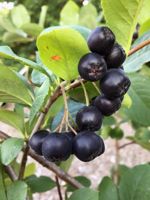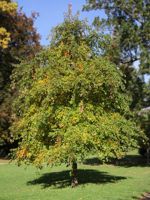Mon-Fri 9am - 5pm Mountain time
Aronia Berry vs Black Gum
Aronia melanocarpa
Nyssa sylvatica
NOT AVAILABLE THIS SEASON - MIGHT RETURN
NOT AVAILABLE THIS SEASON - MIGHT RETURN
Aronia Berry produces black fruit that is often considered too astringent. This is why they are also referred to as Black Chokeberry. It is native to Eastern Canada and the Eastern United States. White to pink flowers appear in the spring which provides a nice contrast to the dark green foliage. In fall the leaves turn a vibrant orange to red.
It has a fast growth rate, strong roots, and can tolerate growing in wet soils. This makes it well suited for various projects including forming hedges, bank stabilization, erosion control, and in wetter riparian areas. They are also well suited as an understory plant as it grows well under other trees.
Aronia berries have their own unique flavour. The polyphenols and anthocyanins are touted as healthy antioxidants and lots of research seems to be underway on the health benefits of this fruit.
Black Gum is a slow-growing ornamental shade tree with a dense pyramidal shape. The foliage is dark green in the summer, and transitions to bright fall colours which include red, orange, purple, and gold. It is commonly used as an ornamental tree in parks and large gardens as a specimen or shade tree.
The small greenish white flowers provide nectar for bees and black tupelo honey is a sought after flavour. The small dark blue fruits which ripen in late summer will attract birds and other animals to your yard. The fruits are edible, but very sour, and are primarily used for pies, flavouring, and drinks. Plant the Black Gum where it will live long-term, as it has a large taproot and does not transplant well.

